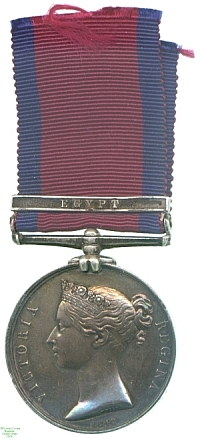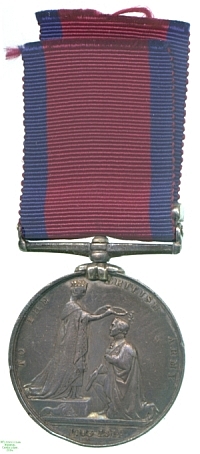
Obverse, a bust of Queen Victoria facing left

Reverse, Queen Victoria on dais placing a wreath on the head of the kneeling Duke of Wellington

Obverse, a bust of Queen Victoria facing left |

Reverse, Queen Victoria on dais placing a wreath on the head of the kneeling Duke of Wellington |
It had been unusual, before the reign of Queen Victoria, for medals to be issued recognising service in campaigns (except perhaps those organised by the East India Company). This left, for example, veterans of the Napoleonic Wars with nothing to display for their service, and therefore three medals were instituted in 1847-1848 for campaigns of the previous fifty years, in the East India Company's forces, in the Royal Navy or in the Army, the last of which was the Military General Service Medal, instituted in 1847 and first struck in 1848.
The intentions of the medal committee are hard to divine, as the medal was struck carrying the dates `1793-1814' in the reverse, but the earliest campaign considered was this one, in Egypt from 1798 to 1801. Earlier battles may have been deleted from consideration due to the shortage of surviving veterans of engagements of the previous century. This was one of the paradoxes shared by all three of the General Service Medals, another being that the monarch whose portrait they bore, Queen Victoria, was not him for whom the recipients had fought.
Although most of the campaigns for which the MGSM was awarded were fought in the Peninsular War, leading to the piece being frequently known as the Peninsular Medal, it was also awarded for conflicts far further afield. In particular, though in the earlier stages of the Napoleonic Wars British successes on land were few, one campaign of which the country could justly be proud was that in Egypt between 1798 and 1801. General Napoleon Bonaparte, not yet in power in France, had conceived the idea of attacking Egypt to cut Britain off from India and was sent to do so at least partly so as to remove him from turbulent Paris. However, facing a triumphant naval victory by Nelson at Aboukir Bay, and a general lack of strategic success despite several crushing victories over Egyptian and Ottoman forces, Bonaparte returned to France in 1799 to take power by coup. In 1801 a force of British troops under Sir Ralph Abercromby, reinforced by East India Company forces, were able to force the surrender of Maréchal Kleber, who had been left in command, and remove French forces from the country.
Service in this campaign was rewarded in 1848 by the bar for Egypt to the MGSM. (A corresponding award was made by the Navy.) This example was awarded to Private T. Sutton of the 24th Foot. Lester Watson purchased it from the dealer Lowe at some point before 1928.